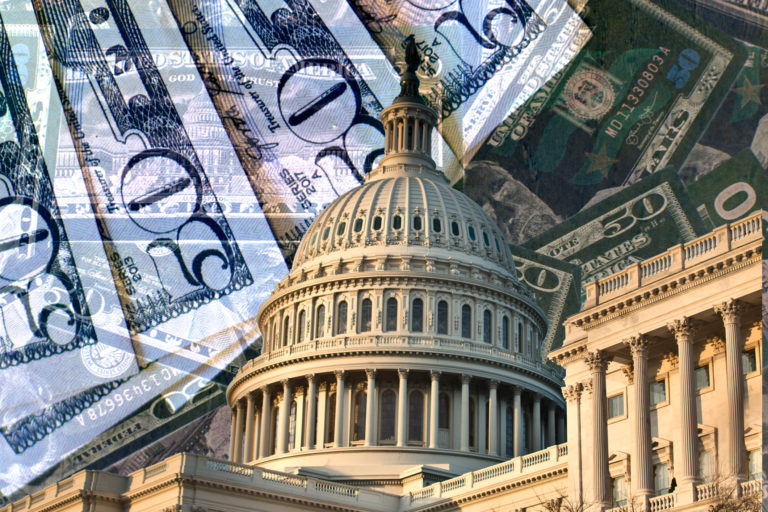
At which trillionth dollar does the national debt become our next black swan event?
It’s the number which needs no formal introduction, and it’s an elephant in the boardroom of every business in America whether acknowledged or not. No strategic plan, economic forecast, or growth projection is complete without cognizance of how a $31 trillion national debt service will muscle its way throughout the US economy. The goal of this article is to raise awareness of how incremental national debt impacts private businesses and explain why a pain-free past of borrowing is no indicator of future consequences from more borrowing. Finally, there are some pointers at the end of the article to help business owners consider how to handle asset valuation changes caused by a national debt crisis.
The main concern in this article is not default risk, as Congress has shown time and again its willingness to raise the debt ceiling to accommodate borrowing to repay borrowing (although a default would be a disaster). Moreover, the immediate unease is not about what rising interest rates will do to debt service costs, as that issue will enjoy several years of delayed consequences (but will likely be an albatross in the not-too-distant future).
The concern today is about how the costs right now of servicing such a swollen balance affects our economy and our businesses in 2023 and beyond. The propellant of GDP growth consists of individuals, being innovative, with new ideas. When the trajectory of our national debt outpaces our GDP growth, the government must either take difficult action to bring this ratio under control, such as, cutting entitlements (social security, Medicare, veterans’ benefits, etc.) or raising taxes. But as evidenced by the recent $1.7 trillion spending bill, and 20 consecutive years of deficit spending, it appears Congress’s and the Federal Reserve’s strategy to service our debt AND keep all other programs afloat is to simply print more money (not literally “printing,” but a proper description nonetheless).
“Money printing” is often viewed as a poor strategy (at best). It must be facilitated extremely carefully (i.e., getting the new money into the right hands at the right time), or else it causes inflation. Supply chain issues, for which the Federal Reserve really has no tools to ameliorate, further aggravates inflation. In 2022, I wrote an article about how a business can thrive in inflation.
The “crowding out” effect is perhaps the most soul crushing consequence of national debt. In macro terms, the government’s Debt to GDP ratio is growing so fast the US Government will need to pay higher returns because of its growing credit risk and to entice investor demand (this also causes interest rates to rise throughout the country) and thus compete against (crowd out) US companies for scarce investment dollars. Simply stated, every incremental dollar of national debt borrowing pulls from a pool of private money that could have gone toward private enterprise investment. Incidentally, paying of higher interest rates by the US Government could cause a worldwide devaluation of US treasury bonds which could trigger a mass selloff.
False sense of security: The economy has floated along for a long time all while the national debt has continued to swell. So, maybe this can go on forever? Not really. The debt has been able to grow because interest rates have been able to descend simultaneously. The lower interest rates have given citizens a false sense of security that swelling national debt doesn’t really hurt the economy and has masked the consequences of debt. That’s likely about to change now that interest rates are rising.
Social contracts, green initiatives, infrastructure, education are all at risk: Within our national budget, a growing interest expense also crowds out important initiatives old and new. There could be a day soon whereby tax revenues are used mainly to pay interest expense, putting fresh new initiatives and necessary ongoing initiatives like social security and military on hold or on more “credit.”
No credit room to handle the next crisis? The U.S. government, in conjunction with the Federal Reserve, utilized debt in spades to power the economy through the 2008 Financial Crisis and the 2020 COVID-19 Pandemic. Some believe that at $31T, we are reaching a ceiling whereby more debt spending to address a future crisis may prove ineffective.
What can a business owner do? Start with the balance sheet, because for companies, this is not so much a profit crisis as it is a valuation crisis. Meaning, assets you think are valuable today could gradually become devalued, due to the upending, domino effects of a national debt swelling beyond its banks. Awareness can be curative. The call to action will be to:
- Fix your rates: Consider fixing any of your debt variable rates. This can be done with a SWAP or converting to traditional fixed rate bank debt. A 50/50 split with fixed and floating rates might work but leaving 100% of debt with a variable interest rate could be risky now.
- With dollar devaluation a possibility, consider hedging against US currency fluctuations.
- Really think through your company’s import/export strategy considering a potential dollar devaluation. A weakening dollar makes imports more expensive.
- Continuing inflation is a possibility in this storm, especially when you toss in the weird supply chain variable. Inflation makes slow cashflow, and holding cash, sins, so make sure you do the things you must to weather an inflation storm.
- CapEx: Review your business’s capital needs for the next 18 months, look to secure financing for that now. Consider a SWAP/Forward rate now to fix the rate until the financing is needed.
- Financial projections: Sensitize EBITDA (both downside and upside) as well as interest rate. In sum, EBITDA projections could be softening in the coming months, expect the best but plan for the worst.
- If contemplating selling your business in the next couple of years, carefully consider how rising interest rates and/or inflation could impact your valuation. Again, with awareness being curative, once you identify the hurdles you can then get to work to resolve, protect or prevent.
- If contemplating buying businesses (Apple Growth Partners’ situation), consider now where and how you will obtain your capital in an environment of inflation, high interest rates, stingy lending, and devalued assets. This is a conversation you’ll want to have with your banker, accountant, lawyer, and investment advisor (strategic advisors). Alternative financing sources may be less vulnerable to interest rate swings.
- Last but not least, ANY strategic plan, whether it be an acquisition, leasing space, expansion…pull out a whiteboard, sit down with your team of strategic advisors, and chart out a Plan B or “in light of plan” that includes the effects of a National Debt crisis. Imagine if we had all been clairvoyant that a pandemic was coming, how might we have planned differently for the future. If you view the National Debt as an impending Black Swan, I believe you’re getting closer to the truth. Simply shining a light on the matter is a great start.
The national debt and government deficit spending are issues over which we, individually, have limited, indirect control (through voting and communicating with elected officials). But when it comes to our businesses, simply being aware of how the national debt can impact operations will give us all a head start and advantage in navigating around the $31 trillion elephant in the room.
If you would like to have a conversation about how the national debt could impact your balance sheet and business planning, please reach out to me anytime at cmullen@applegrowth.com.
Subscribe to receive our blog and other interest-based updates.

